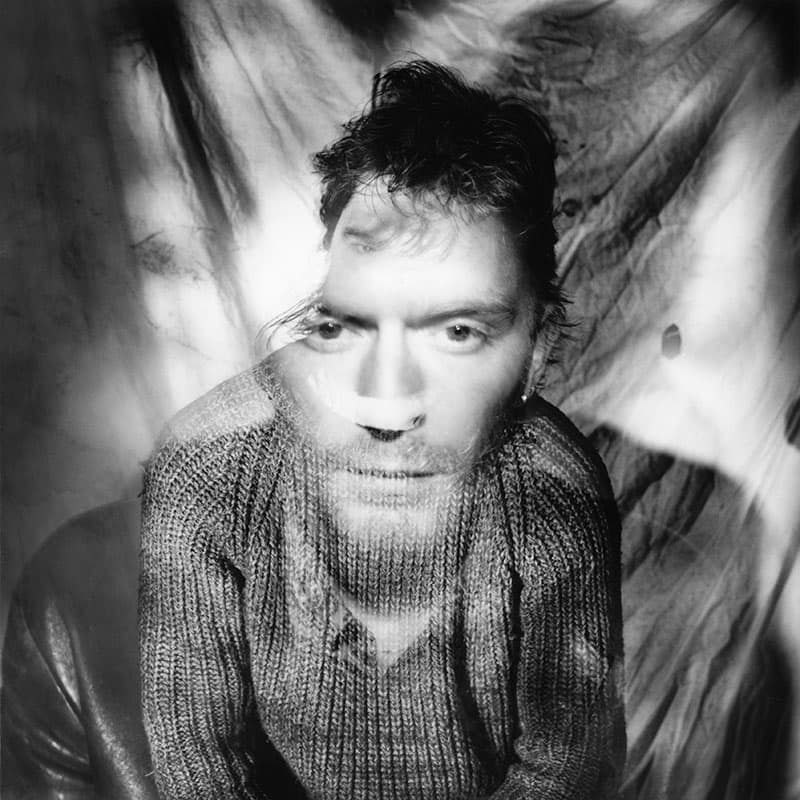Photo Insight with Andrew Sanderson

A renowned photographer, tutor, author and Ilford Master Printer, Andrew Sanderson offers practical tips on working with film and traditional darkroom techniques
In AP 30 March, I read an article about Renan Cepeda, who uses a torch to paint with light for his series of portraits taken on film cameras. It reminded me of this photo, which was also lit in that way, but was exposed onto Polaroid Type 665 film in a Mamiya RB67 medium-format single-lens reflex system camera.
It was shot in 1987 in my attic studio one evening while I was having a few drinks with some close friends who are musicians, artists and photographers. I often photograph people who visit me, and here the sitter was a friend called Dave Ellis.
At that time I was doing quite a lot of imagery using a torch as the light source. The trouble with using a torch is that you don’t know how the image is going to look until you have finished. It’s fairly inconvenient when you are shooting digitally and you have to re-shoot as you find that a part of your image is unlit or overexposed. It is far more inconvenient when you shoot on film and find out much later, after a lengthy processing sequence, that you need to start all over again. Nevertheless, it was a technique I was interested in pursuing, and having willing sitters that evening, I set about trying to produce a portrait that was more interesting than a standard lighting set-up might allow.
The technique I was using to light my portrait at this time was torchlight, some directed on the face and some on the background of the image. The attic studio was perfect for this as I could block out any stray light from other sources easily. The camera has to be left open for the duration of the torch lighting so there’s no shutter speed to recall, and I did not record the aperture, although I would estimate it to be around f/8 or f/11.
While I have mentioned that shooting with torchlight is difficult when using film, shooting on Polaroid Type 665 made life a little easier because it gave a proof print and a negative that could be printed in a conventional darkroom. The quality was good, but the flipside was that it was expensive to use, so each shot had to count.

On this particular evening we did a few shots, then conversation and the drinks took precedence so we took a break from shooting and came back to it a couple of hours, and a few more drinks, later. When I later processed the Polaroid, I found that I had inadvertently double-exposed the film. There was one portrait from before the drinks and another from after.
The accidental double exposure was a pleasant surprise, and although there were other shots created that evening which also worked, and perhaps more in the way I had expected them to, I think this one was my favourite, as it was so unexpected.
I think this image is really interesting. It has a slightly sinister look to it. I remember at the time thinking how it reminded me of Victorian spirit photography.
Spirit photography was ‘invented’ in the 1860s, when William Mumler discovered a ‘second person’ in a photo he had taken of himself. Once he realised this was, in fact, a double exposure, he recreated this technique and used it to doctor negatives so it would appear as if dead relatives were appearing in portraits of people who he was working with as a spirit medium. The technique caught on with other fraudsters, but was later recognised to be a technique in its own right by photographers.
Although my photo certainly doesn’t show a ‘spirit’, the 70x70mm negative that it provided printed well. It needed a bit of burning in where the negative had received double the amount of light, but this was not a problem.
The aim of that evening was to produce a few portraits of friends, something that looked a bit more interesting than the usual portrait lighting set-up would provide – that, and to enjoy a few drinks. And looking back at this photo from the shoot, I think I achieved both of those objectives!
Andrew Sanderson was talking to Debbi Allen
If you would like to read more about paper negatives, Andrew’s book Paper Negative Photography is available from www.blurb.com, price £15








